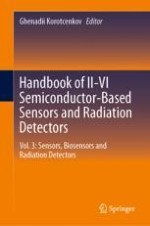2023 | OriginalPaper | Chapter
21. Electrochemical Biosensors
Authors : Mayank Garg, Arushi Gupta, Amit L. Sharma, Suman Singh
Published in: Handbook of II-VI Semiconductor-Based Sensors and Radiation Detectors
Publisher: Springer International Publishing
Activate our intelligent search to find suitable subject content or patents.
Select sections of text to find matching patents with Artificial Intelligence. powered by
Select sections of text to find additional relevant content using AI-assisted search. powered by
